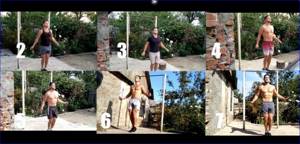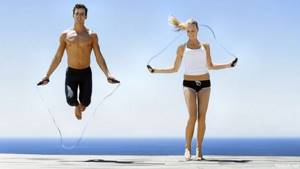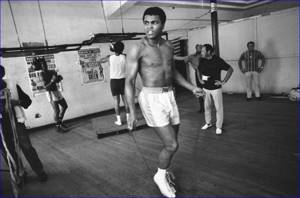Not everyone likes to run; even running fans sometimes get tired of it. In bad weather, you want to replace jogging with an equally intense workout, for example, jumping rope. After a few minutes of jumping, you feel the same as after a full run, but sensations can be deceiving. What is more effective for losing weight and maintaining tone – jumping rope or running? Is it possible to replace jogging with jumping without losing results? Let's look at the advantages and disadvantages of different workouts.
Jogging can be replaced by jumping, but this does not mean that jumping rope is more effective than running. The replacement will have its own advantages, but will not be equivalent.
Jump rope
Jumping rope trains three qualities necessary for a runner at once: endurance, coordination and strength, but at the same time does not put stress on the joints. What's more, if you have cadence issues, jumping rope can help increase your cadence and reduce foot contact time, which is key to speed.
Jumping can be combined with other muscle strengthening exercises: lunges, air squats, planks and SBUs. This kind of training will make you a well-rounded runner because it will strengthen you in ways that running alone can't improve.
Subscribe to “Marathon Man” on Telegram. Announcements of articles and useful selections every week.
Read on topic: Jump rope workouts for runners
Ellipse
The elliptical machine raises your heart rate in the same way that running does, without giving you the high-impact impact that should be avoided for injuries such as jaundice or a stress fracture. And even if you are completely healthy, you can include the ellipse in your workouts, since the movements on it are similar to running ones, and the aerobic system is trained with the same effect.
However, be sure to set the resistance on the machine to make these sessions effective. In addition, on an ellipse it is not necessary to always go forward. You can change direction! This not only relieves boredom, but also changes working muscles. While the forward movement engages the quadriceps, the reverse movement emphasizes the glutes and hamstrings.
Jumping on both legs
The most common method of movement is to simultaneously push off the ground with both legs. In this case, the main load should fall on the front of the foot. Perform the first 100-150 jumps at a slow or moderate rhythm, gradually accelerating.
To work additional muscle groups, try varying this exercise. Jumping on both legs with turns is effective. That is, when touching the floor, the feet should be alternately directed to the right, then to the left.
Be sure to read: Is it possible to lose weight through active sex?
You can also jump from side to side without turning your body. For those who are confident in using the apparatus, you can twist the rope twice in one jump.
But during a break, you can slowly perform two jumps in one turn of the rope.
Another option is to alternate legs together, then apart. The exercise is reminiscent of the favorite aerobic element “jumping jack”, adapted for a jump rope. Your feet should not be placed too far apart; the distance between your feet should be slightly wider than your shoulders.
Treadmill
A mandatory attribute of any fitness room is a treadmill. Unfortunately, the treadmill is not about psychological relief and not about cross-training to strengthen weak areas. It’s more likely about bad weather and being very busy (unless this simulator is at your home).
On a treadmill you can successfully carry out interval training, tempo running, and running at a constant positive incline. What’s remarkable is the ruthlessness of the track: you set a certain pace for the interval, and whether you like it or not, you have to stick to it. Even if you don't want a positive driveway slope, still set it to 1-2% to simulate variable street terrain and air resistance.
Read on topic: Treadmill training: exercises, advantages and disadvantages
30 day experiment
An athlete from the Active Life channel decided to check what would happen if he spent 10 minutes a day jumping rope for a month. The conditions of the experiment were daily training, seven days a week, during which the subject had to jump rope for 10 minutes without stopping.
Starting weight - 90.4 kilograms, waist size - 86 centimeters.

On the first day, it was easy for the athlete to start training, but the training itself was not easy for him. His hands got very tired, but the athlete tried to adhere to the experimental conditions. After 1 week, the athlete already felt that he had become more resilient. The calves and thighs became stronger, the abs became more defined. After completing the experiment, the subject lost 1.5 kilograms of weight, and his waist circumference decreased by 3 centimeters.

Training process during the first week
Yoga
Today, there are a great many resources from which you can get information about yoga. Yoga may not be as great at giving you a cardiovascular workout, but it is undeniably the best way to rejuvenate your body. The only catch is that beginners need to approach their first classes carefully so as not to get overstretched muscles and other injuries.
What yoga will give:
- stretching;
- relaxation;
- flexibility;
- tone.
Read on topic: Yoga and running: 5 asanas for runners
Exercises for losing weight using a jump rope
Surprisingly, this simple tool works real miracles during daily training; it not only reduces BMI, but also tightens muscles in problem areas, including the abdomen and buttocks. And, of course, you will be able to lose weight in your legs with the help of a jump rope, pump up your calves, strengthen your ankles and get rid of cellulite.
It is better to conduct classes in the fresh air, in a park or in the courtyard of a private house, with a warm-up run before jumping. Properly selected shoes can help prevent ankle injuries. These can be sneakers or sneakers that hold it in place well.
To avoid harm to the heart, it is recommended to gradually increase the duration and pace of training. In the first few days, it will be enough to exercise for 5 minutes in the morning and evening hours. You need to jump at a pace that your physical fitness allows.
The main thing is not speed, but correct execution. Carefully monitor your breathing, it should not be interrupted. If trembling in the muscles prevents you from jumping, alternately put one leg forward and bend the other, giving it time to rest.
Be sure to increase the intensity of the load, gradually increasing the training time by 5 - 10 minutes every week, bringing it up to an hour a day. Alternate jumping with easier exercises. To achieve visible weight loss, it is necessary to perform 5 thousand jumps daily for 2–3 months.
To make sports enjoyable and improve your mood, choose cheerful, energetic music for your workouts, which will not only become a wonderful background, but will also set the desired rhythm.
Aerobics
Aerobics, unlike yoga, will significantly increase your heart rate. Aerobics combines exercises borrowed from general physical training with dance movements. This mixture makes rhythmic exercise another option for cardio training. By doing aerobics, you simultaneously pump both your heart and the muscles involved in the exercises. What is not a substitute for running?
Aerobics offers a lot of options for classes: you can do dance or fitness aerobics in the gym, water aerobics in the pool, and if you need to focus on strength, then there is an option here too - strength aerobics with weights.
Bike
Cycling provides the same cardiovascular training benefits as running, but protects your muscles, bones and joints from repeated impact. Cycling, especially hill training, strengthens your thighs, glutes, calves, and more to help prevent imbalances.
It's also a great calorie burner. In a one-hour easy ride, you'll burn the same amount of calories as running, but without the impact on your body: the super-light spin doesn't have any impact, but you're pumping blood through your body, speeding up recovery.
Experts also say that cycling can increase the length and speed of your stride, but in this case it is important to maintain a cadence of 90-100 rpm.
The best cycling workouts for runners are those that mimic standard and classic running workouts. Active recovery, tempo training, short explosive intervals - all this is found in cycling.
The only downside to cycling is that it is much more expensive than running. Here you have the bike itself, suitable clothing, a helmet, and expenses for tubes, chains, repairs, etc.
Bicycle rack
While cycling is good exercise, cycling is better for cross-training a runner. Especially if he excluded this very run from the schedule due to weather or busyness. On a bike station, simulate your running workout by focusing on your heart rate. If you are planning a heavy workout, increase the resistance of the barre and rotate the working interval at the desired level of perceived tension.
What types of bike stations there are, what their advantages are and what applications there are for home training, we discussed in this material: How to choose a bike station for training.
Exercises with jump rope on video
Before you start practicing, decide on the following points:
- Where will you study?
- What will you be doing?
- What type of sports equipment will you use?
Now let's look at these points in more detail.
Place of classes
You can jump at home, but keep in mind that the room is small. You need at least an area of 1x2 meters so that the free space is at least 2.5 meters high. If you live in an apartment, sounds from the ceiling can scare the neighbors below.
It is better that the floor is soft enough and a little springy. You can use a rubber fitness mat. Or you can just go outside and jump on the platform in front of the house. A gym would also be a great option.
Cloth
For jumping, you need shoes that provide good ankle support. You will also need sportswear. It should be a tight-fitting form made of thin, breathable materials so that your movements are free and there is no interference when turning.

Girls should wear a sports bra. You can put on light sneakers on your feet, which gently fix the ankles and provide fairly good lateral stability. This is important for joints, the load on which will become more uniform and there will be less risk of damage.
Choosing a jump rope
Jump ropes come in the following types:
- Weighted. They have a noticeable weight and help to load the muscles more heavily, which will promote their growth. Please note that jumping on such a rope may be difficult for untrained people.
- Express. Perfect for fat burning. They make it possible to make a large number of jumps per unit of time. Suitable for those who want to lose weight as quickly as possible.
- Electronic, equipped with a calorie burning counter. When using such a jump rope, you just need to weigh yourself and enter your parameters into the counter. And then the “smart” device itself will calculate the number of calories burned. Additionally, such jump ropes can be weighted or high-speed.
- Simple with a rubber torso. These are the most common jump ropes, familiar to us since childhood. They are also great for weight loss.
If we talk about length, then its standard indicators are 2.4, 2.7 and 3.0 meters. To choose the right length, you can focus on the following: for a height of 1.65 cm, a jump rope 2.4 meters long is suitable. When choosing a jump rope, you can do this: take the device by both handles, stand up straight, straighten your back and place your foot on the hanging torso. Start lifting the rope up. If you can bring the handles to armpit level, the length is right for you.
The length of the rope is a parameter with which you can not be afraid to make a mistake. It can be a little longer - they are usually equipped with special handles that allow you to reduce the size of the cable.
Cycling
It would seem that cycling should not be placed in a separate area, since this is the same pedaling as on a bicycle station and a bicycle. However, cycling is a separate direction in fitness, providing high-intensity group classes and combining an exercise bike and dancing. You won't be able to spin relaxedly here.
In cycling, both “cycling” and “running” muscles are involved, but trainers also actively involve the arms, abs, and shoulders. During cycling, riders do push-ups, do crunches, in a word, pump up their whole body. So, if you don't want to separate strength training and cardio, sign up for a cycling studio.
What is cycling and can it replace cycling?
Walking
This is perhaps the most affordable way to give yourself at least some exercise. Leave the car and walk to work, run errands, take a longer walk with the dog - there are a lot of options on how to harmoniously include walking in your regular schedule.
What are the other benefits of regular walking? It can never be wrong: you don’t need to look for a trainer to set up the technique, you don’t need special equipment and shoes, although, of course, under no circumstances go for a walk in stiletto heels or other uncomfortable shoes.
Walking allows your body to expend extra energy, but the problem is that this exercise stimulates your appetite, so you also need to continue to watch your diet. Walking does not burn calories, and people overeat much more often after walking than after jogging. We wrote about this in the article Walking: types, benefits, calorie consumption.
Nordic walking
Today, Nordic walking has gained love all over the planet. And for good reason. Walking with specially designed poles burns the same amount of calories as running, working not only the leg muscles, but also the upper body. This type of activity is not high-intensity; rather, it is aimed at developing general endurance, so it will be a good alternative to light cross-country.
Nordic walking is often prescribed by doctors for the rehabilitation of patients after operations on the musculoskeletal system, so there is no doubt about its gentle effect on the body. However, if you decide now to buy poles and go for a walk, first familiarize yourself with the Nordic walking technique. Following the correct technique will prevent you from getting injured from such a harmless sport.
It is also important to note that Nordic poles cannot be replaced with ski poles. Approach the selection of this equipment consciously. How to choose - read in a separate material: Nordic walking with poles: benefits, technique, beginner mistakes.
Reviews about the effectiveness of skipping
Confirm or refute the reality of the possibility of losing weight with the help of a jump rope, reviews from those who have already tried.
Irina, 35 years old
The happiness of motherhood brought me an extra 10 kg, I really wanted to quickly return to my previous shape. I decided to choose a jump rope because of the opportunity to practice at home and the ease of training. I am very pleased with the result, in 2 months I managed to lose 9 kg and tighten the skin in problem areas
Maria, 45 years old
I am an experienced hypertensive patient, and on the advice of a friend, I decided to try the miraculous properties of a jump rope on myself. Without consulting a doctor, I started training. Instead of losing weight, I suffered a hypertensive crisis. I encourage everyone to take their health more seriously.
Natalya, 28 years old
I work in an office and often stay late. I began to notice that I couldn’t climb to the 5th floor without shortness of breath. Over the past year I have gained 3kg of excess weight. On the Internet I was attracted by a fashionable word - skipping. I read it and realized that this sport suits me perfectly. There will be an incentive to spend more time in the fresh air. Now every morning I start with a short jog and a 30-minute set of exercises with the obligatory use of a jump rope. Within a month I returned to my previous shape, my overall health and mood improved.
It should be recognized that a jump rope can be not only a means of organizing children’s leisure time, but also an excellent exercise machine. Don’t be lazy and be healthy, and don’t forget to share the information you receive on social networks with your friends!
general physical training
There are a great many options for training in the gym or at home to strengthen your back, abs, arms, legs, which allows you to make each activity different from the other.
Check out the program here: 50 Developmental Exercises for Runners
At home, you can practice running in place, running with high hips (also in place), jumping from a half-squat, swinging from a lunge, and many different planks.
Exercises with your own weight do not require equipment or going to the gym; you can do them at home or on the street. Detailed instructions with videos of exercises can be found in this material.
How to properly perform jumping rope
There are many conflicting reviews on the Internet on the topic of whether it is possible to lose weight with a jump rope, studying which it becomes clear that failures are associated with incorrect or irregular performance of the exercise. The secret to success is the correct technique for performing jumps:
- Stand straight, jump up, as if trying to reach the ceiling with the top of your head.
- Perform springy movements as you lift off the floor and land.
- Press your elbows tightly to your body, and rotate the rope exclusively with your hands.
- Land gradually and lightly, first on your toes, smoothly lowering your entire foot, while keeping your legs bent. Another landing technique (on your heels with your lower limbs level) can damage your kneecaps and cause the spine to sag.
Having mastered the principles of proper safe jumping, you can begin to perform a set of exercises to bring your weight and figure into shape.
Swimming and running in water
If you suffer from joint pain or injuries, swimming may be just what the doctor ordered. Without affecting the joints, this load makes maximum use of your entire body and cardiovascular system. In addition, if you are not a fan of strength training, swimming is a good substitute for strengthening your upper body.
Research suggests that swimming in a pool for an hour three times a week for ten weeks can increase your VO2 max by 10%.
If you don’t know how to swim, there is an option to do aquajogging (running in water) in the pool. This is the same running, but without the impact load, which, as you can see, is the basis of all running injuries. For underwater running, get an aqua fitness belt that will keep you afloat. Running in water, due to the resistance of the water, is harder than regular running on land, and this is an advantage for your muscles, because they are used in much the same way as if you were running with a tire behind you or with other weights.
The benefits of swimming: 20 reasons to go to the pool
How many calories can you burn with a jump rope?
Getting a slim figure takes some effort, and how to quickly lose weight with a jump rope depends on many factors. The number of kilograms lost and energy expenditure will directly depend on your consistency, persistence and activity, as well as on your initial body weight, type and intensity of jumps, lifestyle and type of nutrition.
When skipping at a moderate pace, a person burns 60–70 kg in 10 minutes, about 115 kcal, and in 30 minutes, about 300 kcal. These figures are almost 5 times more energy expenditure when walking.
If you adhere to the pace of jumping at least 70 times per minute, then increase the amount of energy expenditure by 35% - 400 kcal in 30 minutes, and when performing high jumps up to 460 kcal in 30 minutes.
Skis
In summer - a runner, in winter - a skier. You probably also have friends who hide their sneakers and take out their skis during the snowy season. And this has enough advantages if you are not faced with the task of winning the Russian championship.
The obvious advantage of skiing over running is the low impact factor on tendons, ligaments and muscles. During running, the average impact force is approximately two to three times your body weight, but in skiing practice this is not the case. Above, we have already considered quite a few types with a low impact factor, but only cross-country skiing (classic skiing) uses the same muscles that work in running. The obvious advantage is that this also adds work to the upper body, which is little involved in running.
For those who don't like long runs, the good news is that an hour of skiing equals 75-80 minutes of running. This means you get the same physical benefits as running, but in less time.
The benefits and harms of such exercises
Like any exercise, such a monthly race with excessive fanaticism can be harmful to health. If a beginner athlete feels that 10 minutes a day is too much for him, you can break the workout into 2 parts with a break. Still, it’s better to take at least one day off between two weeks of classes. After all, the muscles must be given rest.
Ligaments and joints also need rest; repeated exercises with a skipping rope inevitably overwork these parts of the body. Overloading the body is fraught with injuries and sprains, which will cause much more harm to the training process than resting for one or even several days. You need to train wisely.
But if everything is done correctly, such exercises will benefit the athlete. The beneficial effects of jumping rope have been noticed for a long time. Not a single training session for a professional boxer is complete without ten minutes of work with this tool. This type of work has a beneficial effect on the endurance and flexibility of the body, and also burns fat. The whole body loses weight, first the sides will go away, then the stomach, and finally the fat will leave the legs and thighs.

Muhammad Ali pays special attention to rope work before his first fight with Sonny Liston, 1969











